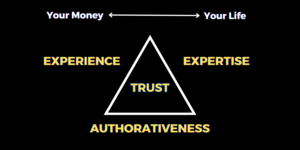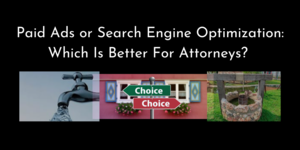With the increased attention on search engine optimization (SEO), the importance of content (and now video content) continues to grow. In many niches and verticals, video with its capability to communicate visually, auditory, and textual is becoming a powerful means to attract attention and nurture relationships with prospects and customers.
Where To Start
Before we talk about specific types of content, it is best to address the fundamentals of what defines “good” content.
The primary objective of content is to convey information. Within the realm of SEO, content is intended to satisfy requests searched by users. Search engines (ex. Google, Bing, etc) exist to provide the best results to satisfy user queries.
If your content accomplishes this goal, it will rank on the search engine results.
When developing content to best satisfy the user intent, it needs to be relevant based on three characteristics.
- Industry
- Location
- Associations

Industry
Industry relates to the topical or functional area relevant to your information. Depending upon the subject of your content, this often makes up the “facts” about your content.
Note: Of the three characteristics, this is normally the one best satisfied. Since content is topical and those sharing it are highlighting their expertise, this requirement is most-often met.
Location
Because this is such widespread availability of content worldwide, material that addresses local interests or unique variances improves rankings in those areas where it is most relevant.
Where users have language or similar requirements, adding locally-identifying factors to content pieces enables search engines to better deliver it to the most appropriate audiences.
Note: By using location relevance to more-closely align content in one geographic region, it can also limit its delivery to users outside of that area.
Associations
Identifying the individuals or groups to whom the content is most valuable is another technique for distilling an audience to its most-likely interested parties.
On social media platforms, these might take the form of Groups or Hashtags but identifying the intended audience for content functions in a similar fashion within search results.
Why Video?
For many professional and service-based niches, there is minimal competition for video-format content. While it can be easily created and produced, it is more readily consumed by users

Benefits gained among our three senses influenced by video acts in a synergistic fashion increasing retention to near-60%. These effects on Recognition, Awareness, and Trust should not be underestimated.
Content Types
This post will highlight video content types that can be developed from two main sources.
- Interviews
- Demonstrations
Interviews
Interview-style content refers to videos usually between a host and one or more subjects. They tend to be topical in nature with the interview subject (or subjects). Based on their location and/or association, they help deepen the connection between the interviewer and the audience.
This content category serves to increase the brand and perceived level of expertise for the interviewer.
These types of content are only limited by the availability of interview subjects.
They include, but are not limited to:
- “Digital Mayor”
- Case Studies / Customer Interviews
"Digital Mayor"

Local-interest or “Digital Mayor” interviews are some of the easiest and most-effective pieces of video content that one can create.
It may or may not be specifically associated with one’s niche, but the high factors of local interest help to strengthen the interviewer’s connection to their local service area.
By increasing one’s influence within the local area overall, they also gain notice for their expertise within that local area.
Note: The 20-second “outtro” serves the same purpose as an advertisement or biography included at the end of a show, article, or other content pieces. Record one that can be reused with any of these video types.
To create one of these videos:
- Develop 2-3 standard questions that you ask to all subjects
- Identify subjects to interview
- Ask 2-3 questions highlighting their relationship to your local area
- If there are associations between their experiences/expertise and your niche, be sure to highlight them
- (Post-interview – Ask if there are others whom you should interview and to whom they could introduce you)
Long-term Goal: A continually-evolving series of interviews with locally-relevant individuals and groups within your area of service.
Case Studies / Customer Interviews
Note: This slide is an example of a Case Study / Customer Interview video that could be recorded by a Bankruptcy Attorney. While some clients may not wish to recount the past situations, these stories by those comfortable sharing them can powerfully share the value that a business provides during a time of stress or dissatisfaction.

Case studies and customer interviews are strong trust-builders highlighting the value that a business delivers. Prospects can relate to the need (or want) that a customer had and stories of who and how it was satisfied are sure to spark interest.
Unlike the “Digital Mayor” (i.e. Local Interest) interview, this type focuses on similarities and associations within a market. Often, businesses and professionals within the same niches experience similar problems and follow similar stages of growth.
Stories of how others overcame shared problems or worked through common obstacles highlight connections and identify the interviewer as a common voice among the audience.
To create one of these videos:
- Again, develop 2-3 standard questions that you ask to all subjects
- These should be conversational about the industry or niche to highlight their subjects membership within the group
- Review 30-60-90 day recent results to identify 1 or 2 areas of value to discuss
- Ask the client to share their prior challenges in these areas as well as solutions your business provided
- If there are individuals who provided value over and above expectations, ask if they can be highlighted. Note: Stories about your team (as opposed to you) build the trust in your business and brand!
- (Post-interview – Review the final interview with your client to ensure that they are comfortable with everything shared or said)
Long-term Goal: A growing set of interviews with recognizable individuals and businesses within the niche you serve who credit you and your company for parts of their success.
Demonstration
Demonstration videos share steps required to perform some action or show the value/utility of some product or service. When done properly, they are focused on a specific topic and elevate the perceived expertise of the presenter relative to the subject matter.
They include, but are not limited to:
- How-To
- Walk-Thru
How-To

How-To topics that highlight knowledge or a skill are content types that work well in video format. Because of the rise of search-based queries (ex. Google, Bing, etc), these types of videos are some of the best for acquiring organic traffic and attention. Explaining topics that users find complex is a quick way to highlight experience and knowledge which builds trust.
To create one of these videos:
- Start by showing and describing the end result which ensures the viewer knows what they are working toward
- Include preliminary views/lists of any required materials or tools
- Share the steps to accomplish some goal in the order that they need to be performed
- Be sure to vary viewpoints as needed between face-on descriptions and any needed close-up images or diagrams
Note: If there are confusing or challenging steps, these can serve as opportunities to create separate How-To videos focused entirely on that action (or set of actions). How-Tos are great opportunities to decompose complex activities into discrete, consumable chunks. In doing so, each can be separately indexable and searchable.
Long-term Goal: A collection of indexable and searchable videos where individuals get answers to common problems.
Walk-Thru
Note: This slide is an example of a Virtual Walk-Thru video that could be recorded by a Real Estate Professional. Any product or service demonstration where prospects are shown features and function can function in this fashion.

A Walk-Thru type of video highlights common (and unique) aspects of a product or service.
Instead of an in-person showing which might have been the norm in the past, our wide-area capabilities (especially in our current Covid-19 environment) have opened the need for more virtual options. Lacking the capability to “touch and feel”, the experiences of what we see and hear are even more important.
To create one of these videos:
- Using your camera, walkthrough, or around showing the subject from different vantage points
- It is often beneficial to have another person hold the camera as they can respond as you point out/highlight specific areas of interest
- The “assistant” can also focus attention back on the demonstrator as appropriate to provide a more conversational experience for the viewer
- Ensure that the demonstration flows naturally as opposed to creating a “slideshow” style of experience
Long-term Goal: A set of videos that show the kinds of products or services that your business provides
Time-Lapsed (What We Did)

A Time-Lapsed video has similarities to Demonstrations and Interviews (more specifically Case Studies), but they have unique characteristics making them separate from either.
They are subtly different from Demonstrations because they highlight not “how to do something”, but “how we did it”. This likens them to Case Studies, but it is less about the value-added for a customer and more about improvements to a product or object.
These videos highlight expertise and experience by showing improvements over time.
To create one of these videos:
- Using your camera, record time-lapse changes over time from similar perspectives and viewpoints
- It is often a good practice to show the end result/outcome early in the video to show a viewer where it will end up
- Conclude with Before-After images from those similar vantage points to show progress over time
Long-term Goal: Videos that show proficiency and expertise adding value in your niche or industry
Wrap-up
Video content continues to grow as a means to communicate with audiences, prospects, and customers.
It is easily indexable and searchable making it a prime candidate for attracting organic traffic. Once published, it offers long-term opportunities to add value for audiences to nurture engagement (and hopefully conversion).
The content types covered include:
- Interviews
- “Digital Mayor”
- Case Studies/Customer Interviews
- Demonstrations
- How-To
- Walk-Thru
- Time-Lapse
With a blended strategy for publishing, individuals and businesses can grow their influence within their niche (Industry), local service areas (Location), and topics of interest (Associations).
If there are other video content types that you would like to share, include them in the comments down below.


